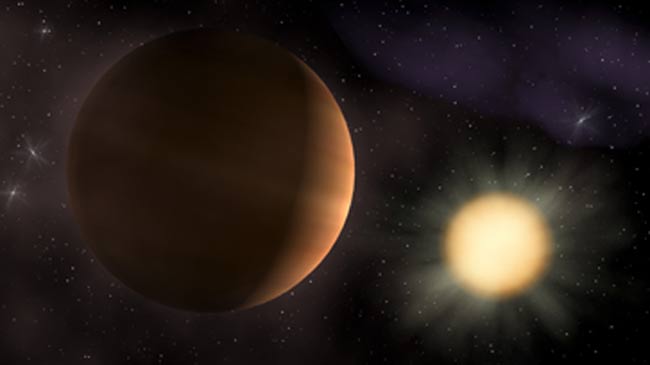
A planet slightly larger than Jupiter was recently spotted as it passed in front of a Sun-like star 500-light-years away. Called TrES-2, the new extrasolar planet is the second to be discovered using telescopes built from off-the-shelf components similar to those used by amateur stargazers.
It is also the first to be spotted in a swath of sky NASA has targeted for a future mission that will specifically look for Earth-like worlds.
The finding will be detailed in an upcoming issue of Astrophysical Journal.
TrES-2 belongs to a class of extrasolar planets called "hot Jupiters." While roughly the same size as our solar system's Jupiter, TrES-2 orbits about 130 times closer to its star-called GSC 03549-02811-than Jupiter does to our Sun. TrES-2's close proximity to its star means it takes only about 2.5 days to make one orbit. Jupiter, in contrast, takes nearly 12 years to make one full orbit around the Sun.
TrES-2 was found using the transit technique, which takes advantage of the slight dip in starlight that occurs when a planet passes in front of its star. By measuring the decrease in brightness, astronomers can glean valuable information about a transiting planet, including its mass and size.
TrES-2 is different from other known transit planets, however, because it crosses the face of its parent star farther from the star's equator than any other known planet. This unique property could allow scientists to one day measure properties for TrES-2 that are completely unknown for any extrasolar planet.
"We may be able to find out the tilt of the host star's axis, whether the planet has moons or rings, whether there are other planets around the star, and much more," said study team-member Georgi Mandushev of the Lowell Observatory in Arizona.
Get the Space.com Newsletter
Breaking space news, the latest updates on rocket launches, skywatching events and more!
TrES-2 is the first transiting planet discovered in the Kepler field, a swath of the sky that will be surveyed by Kepler Mission, a NASA space telescope specifically designed for spotting extrasolar planets and slated for launch in 2008.
"Kepler will find lots of objects like TrES-2 in its quest to discover Earth-size planets orbiting other stars," said Edward Dunham, another Lowell Observatory scientist involved in the discovery. "I imagine that TrES-2 will be one of Kepler's first targets, and will be an old friend by the end of the mission."
TrES-2 was detected using the three automated telescopes that make up the Trans-Atlantic Exoplanet Survey (TrES). These include the Sleuth telescope at Caltech's Palomar Observatory, the Lowell Observatory's Planet Search Survey Telescope (PSST) and the Stellar Astrophysics and Research on Exoplanets (STARE) telescope in the Canary Islands.
All were small 4-inch (10-centimeter) telescopes built using a combination of off-the-shelf parts and custom-made lenses. "It's all really quite small scale, you might call it desktop-type hardware," Dunham told SPACE.com. "It's not the industrial-strength stuff like these big telescopes that you see."
Currently, some 200 extrasolar planets are known; eight of them were discovered using the transit technique. TrES-2 is the second transiting planet discovered using the TrES network. The first, TrES-1, was discovered in 2004, and involved a Jupiter-sized planet orbiting a different star also located about 500 light-years away.
- The Top 5 Telescopes of All Time
- Backyard Telescope Helps Find New Planet
- Report of Earth-Sized Planet Around Another Star Premature
- Kepler Mission to Find Earth-Like Planets Gets Green Light
Join our Space Forums to keep talking space on the latest missions, night sky and more! And if you have a news tip, correction or comment, let us know at: community@space.com.
Ker Than is a science writer and children's book author who joined Space.com as a Staff Writer from 2005 to 2007. Ker covered astronomy and human spaceflight while at Space.com, including space shuttle launches, and has authored three science books for kids about earthquakes, stars and black holes. Ker's work has also appeared in National Geographic, Nature News, New Scientist and Sky & Telescope, among others. He earned a bachelor's degree in biology from UC Irvine and a master's degree in science journalism from New York University. Ker is currently the Director of Science Communications at Stanford University.









